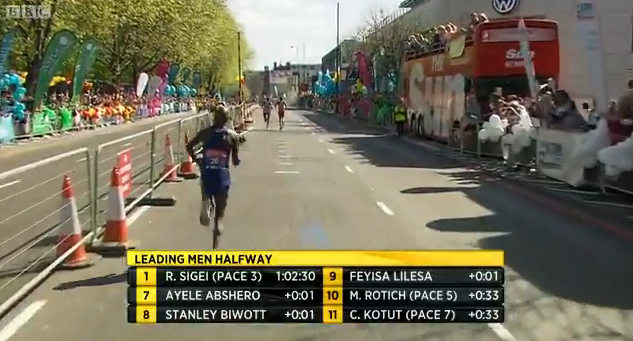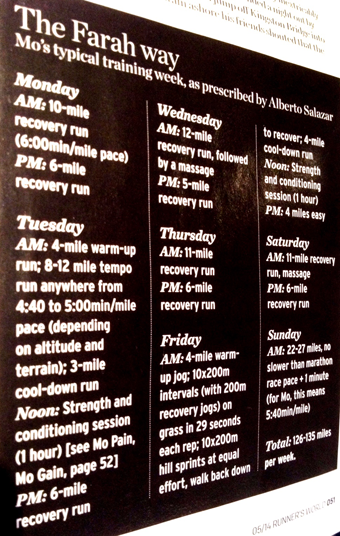In his highly-anticipated debut over the 26.2 miles Mo Farah crossed the finish line in 8th place in a time of 2:08:21. Mo set a new English marathon record and completed the London course 12 seconds faster than Charlie Spedding’s 2:08:33 performance in the 1985 London marathon. Steve Jones’ British marathon record of 2:07:13, set in the 1985 Chicago marathon remains intact. In the British all time rankings, Mo’s debut marathon is the fourth fastest time by a British athlete over the marathon distance. Only Welsh athlete Steve Jones ran faster on four occasions: 2:08:06 Chicago (1984), 2:08:16 London (1985), 2:07:13 Chicago (1985) and 2:08:20 New York City (1988). Considering Steve Jones achieved 3 out of 4 of his best performances outside the UK on a different course, Mo’s marathon debut was the second fastest marathon time achieved in the UK. However, the 1985 and 2014 London marathon route are not identical. Minor changes have been made to the route since 1985. For example, the cobblestoned area near Tower Hill has been cut out from the original course in 2005.
While we think Mo’s 8th place and 2:08 is still a very good time for a debut marathon by world-class marathon standards (sub 2:05), media and critics have raised concerns about Farah’s future marathon potential. As a multiple European, World and Olympic champion on the track and European Record holder for 1500m and 10000m the general public assumed Farah would be able to replicate his track success on the roads.
I have watched the London Marathon near mile 13.3/22.2 mark with a fellow endurance coach. I thought I write up a quick note based on what I observed before, during and after the Virgin Money London Marathon.
Choice of competition schedule
March, 16th Mo competed in the New York City Half Marathon. The NYC Half Marathon took place 4 weeks before the Virgin Money London Marathon on the April, 13th. A typical marathon schedule would reach peak weekly mileage and intensity 4-6 weeks before the target race. It is not uncommon that elite athletes take part in a spring half marathon. In previous years, the Lisbon Half Marathon was a favourite and more recently the New York City Half Marathon raised its profile to attract London/Boston marathon-bound elite athletes.
At the time Mo was training in Item, Kenya and had to leave his training base to travel across 7 time zones to New York City to face very cold/windy conditions (-1 C/18 mph wind). After weeks of hard training racing in New York was an opportunity to assess his form, perhaps attempt a sub 60 mins 1/2 marathon time and more important to catch up with his family.
The race was won by Geoffrey Mutai in a time of 1:01:50 and after falling down Mo had to run by himself to chase Mutai. Farah managed to chase Stephen Sambu and crossed the finish line in 2nd position with a time of 1:01:07. A couple of minutes after Mo finished he passed out and was rushed off in a wheelchair. A worrying experience, though Farah recovered quickly and was fine. After the race Mo had to cross another 7 time zones to travel back to Kenya to resume altitude training.
Looking at Mutai’s and Farah’s London marathon performance, both were disappointed. This would suggest that the timing of the ½ marathon and the related travel was not ideal. Travelling 1-2 days from Nairobi to New York City and back crossing 7 time zones, adjusting to different climate zones including recovery from the 1/2 marathon race is quite disruptive when preparing for a marathon.
Wilson Kipsang in comparison did not took part in a spring ½ marathon . He continued to remain at his training base in Kenya. The same strategy was adopted by Stanley Biwott (KEN) and Tsegaye Kebede (ETH). Biwott was scheduled to run the fast half marathon in Ras Al-Khaimah (RAK) in the United Arab Emirates (UAE), but eventually withdrew from the race due to an ankle injury.
In case if a half marathon was required as part of Mo’s build up to the London Marathon a better choice would have been (for example) to take part in the Ras Al-Khaimah (RAK) Half Marathon. RAK is held February 19th, which is 8-9 weeks before the London Marathon. RAK is an IAAF approved course, very fast, offers generous prize money, attracts a quality field and would have been in line with Mo’s expectation for a sub 60 minutes ½ Marathon clocking and opportunity to break the European Half Marathon Record. The travel from Kenya to UAE would have been less disruptive.
At this stage Mo has not made any further announcements regarding another fall marathon this year and his long term plans for the marathon. However, it would be worthwhile making sure a build up race is not scheduled too close to the target marathon race and aligns with the peak volumes and intensities.
For us mere mortals looking for more local options: Watford (February), Wokingham (February), Brighton (February), and Reading (March) are good choices for a half marathon during the build up to London. Ideally, the course profile of the half marathon should be the same as the target race.
Better Pace Makers
Mo’s race strategy was to settle with six others (Jeilan, Kiprotich, Dos Santos, Paula, Mesel, Rotich) for the second pace group. The leading group of seven runners (Kipsang, G. Mutai, E. Mutai, Abshero, Kebede, Mekonnen, Biwott) was paced by Haile Gebrselassie targeting the course record (or even the world record 2:03:30). The second group was targeting 62:15 (2:04:30), 30 seconds behind the leaders at half way. This would allow Mo to have a chance in the 2nd part of the race and attack Steve Jones British marathon record of 2:07.13.
Unfortunately, as it turned out the pace makers did not do a good job. Haile started too quick with a 4:36 opening mile, a 14:21 5k time which corresponds to 2:01 pace and he was not able to pace until the ½ way point. The 2nd group was not working effectively. The pace makers were quickly adrift after 10k and ran 50-80 meters in front of Mo. While others in the pace group were happy to settle behind Mo, Mo had to put in a lot of effort to maintain the gap to the lead group, which meant he could not speed up any further during the 2nd half. A missed drinking bottle and running the majority of the race solo contributed to a sub-optimal performance.
It was a wise move to settle for the 2nd pace group as the pace of the lead group was too fast. The combination of both pace making efforts, meant that Farah’s did not benefit of the pacers and ended up running the majority of the course without effective pace makers. His split were 63:08 and 65:13.
Better communication with the pace makers before the race and adopting a more dynamic race plan would be required. For example, the pace makers should have dropped back and stay with Mo and pick up the pace gradually again. Alternatively, there has been an argument to abandon the use of pace makers.
Marathon specificity
A typical week of Mo’s training regime was posted on RunnersWorld and Twitter. We do not really know how accurate the posted information about his training is. However, in various interviews his coach Alberto Salazar stated a similar structure. Assuming the training has been done at altitude, training paces need to be seen in context.
According to Mo’s training programme, a typical week would start Monday, two recovery runs, a longer run of 10 mile in the morning and shorter run of 6m in the afternoon. Tuesday consists of a marathon paced training run. For example, after a warm-up 8-12 miles at marathon pace (4’40’’ to 5’00’’). The training unit is followed by a strength & conditioning session in the afternoon. Wednesday and Thursday are similar to Monday. A massage between the two runs would happen on a Wednesday. Friday, is about speed development, shorter 200s and hill sprints followed by a strength & conditioning session. Saturday, is again the same as Monday. Finally, Sunday is a long run of up to 27 miles, run at 1 min slower than target marathon pace (5’40’’).
Mo’s training mainly revolves around weekly mileage, steady easy runs (for 4 days), a marathon pace run, a slower long run and a weekly speed development session. Based on the information provided the marathon paced runs have very little variety or progression, similar with the long run. Paced runs at marathon pace could start slower, though could be longer of up to 16m with a pace progression. Strides could be incorporated to refine Mo’s running mechanics. Long run pace and marathon work is considered separate. For example, progressing the pace or including a marathon pace block in the long run is not part of the programme.





